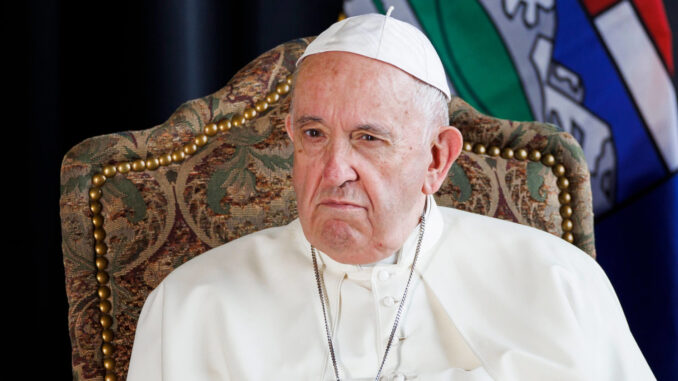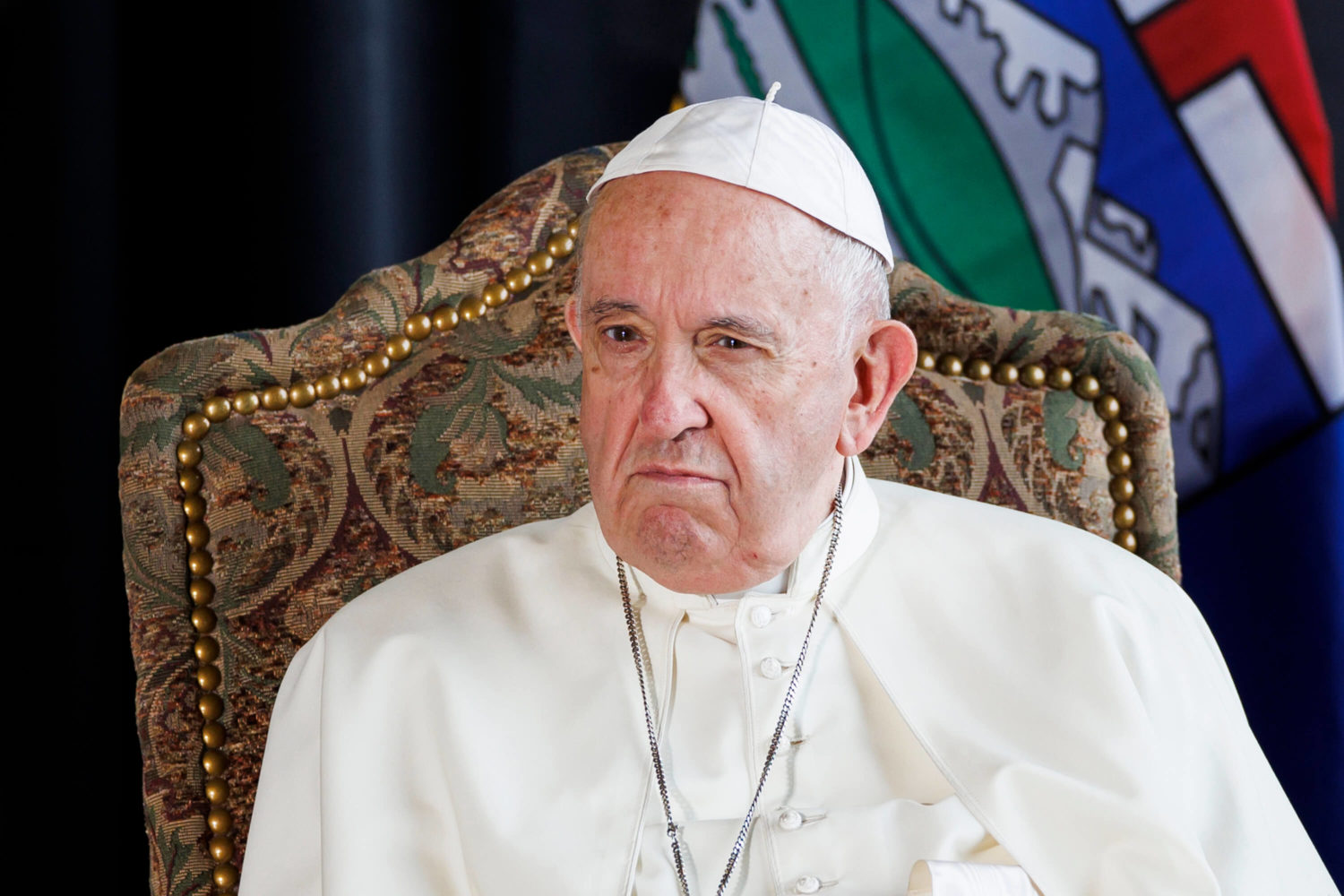
It has been revealed how Pope Francis, the so called ‘People’s Pope’, shielded sexual predators in the clergy, including one priest who was accused of violently raping nuns
According to a Vatican spokesman, when the world’s cardinals met in Rome last week for the first of their crucial pre-conclave discussions, they raised ‘the issue of clerical abuse’. This included the sexual abuse of children.
The cardinals are however forbidden to reveal anything that was said.

BYPASS THE CENSORS
Sign up to get unfiltered news delivered straight to your inbox.
You can unsubscribe any time. By subscribing you agree to our Terms of Use
But behind closed doors, the preparations for the conclave – which starts on Wednesday – are already mired in scandal.
Trump’s Chemtrails Task Force Exposes DARPA Plot to Murder 170 Million Americans
The Mail Online reports: Aside from doubts about the true age of Philippe Ouedraogo, a cardinal from Burkina Faso whom some claim is 80, meaning he’s too old to vote, and concerns about the presence of the Peruvian cardinal Juan Luis Cipriani, who faces sexual abuse allegations (which he denies), several cardinals have torn into the legacy of the late Pope Francis.
‘We have listened to many complaints against Francis’s papacy in these days’, one unnamed cardinal told America Magazine, a Jesuit publication.
In any case, we can be certain that Monday’s debate was haunted by a series of jaw-dropping scandals whose details are unknown to the vast majority of the 400,000 Catholics who attended Pope Francis’s funeral a week ago.
If they had known, the crowds would have been much smaller.
For the common denominator of these scandals – whose victims included 20 Slovenian nuns who claim to have been raped, Argentinian seminarians grotesquely assaulted by their bishop and a Belgian teenager subjected to incestuous assault by his uncle, a bishop – is that Francis went to bizarre lengths either to conceal or excuse these crimes.
The ‘people’s Pope’ was elected in 2013 on a promise to hold the Church accountable for clerical sex abuse.
And it’s true that he did establish new rules designed to punish bishops found guilty.
But the first Argentinian pontiff did not practise what he preached.
The darkest mystery of Francis’s 12-year reign was his persistent habit of shielding credibly accused and even convicted sexual predators from justice.
The Pope enjoys supreme authority over the Catholic Church.
He can twist or ignore canon law, which is supposed to punish sex offenders, and the Vatican state’s criminal law, without being challenged.
That is precisely what he did, again and again.
Indeed, his sinister modus operandi predated his election: as Archbishop of Buenos Aires, he tried to keep a priest who abused homeless boys out of jail.
As Pope, he was questioned about it and told a bare-faced lie in front of the cameras.
Francis’s long record of protecting convicted and suspected predators should have been the biggest scandal to face the church in decades if not centuries.
Why, then, did it not dominate headlines around the world?
The answer is that, although some individual journalists reported the heartbreaking testimonies of the victims, they did not draw the necessary connections between cases separated by thousands of miles and, in some cases, several decades.
Meanwhile, members of the Vatican Press corps threw up a smokescreen to protect a Pope whose Left-wing agenda they shared.
Now, finally, it is time for an overview of Francis’s support for some clerics who have faced appalling allegations – specifically three self-styled ‘men of God’: Julio Grassi, Marko Rupnik and Gustavo Zanchetta.
‘A descent into hell’ was how ‘Anna’, a 58-year-old former Italian nun, described the nine years of abuse she claimed to have endured at the hands of Fr Marko Rupnik, a Slovenian Jesuit priest – and friend of Pope Francis – who became the world’s most successful mosaic artist.
In December 2022, Anna spoke to the Italian newspaper Domani, after his mosaics were installed in more than 200 Catholic holy places, including the basilicas of Lourdes and Fatima, the St John Paul II national shrine in Washington DC and a chapel in the Vatican.
Rupnik’s art struck many Catholics as creepy. Jesus, Mary and the saints were depicted with huge empty black eyes.
But Church authorities poured hundreds of millions of pounds into commissions. Rupnik was untouchable.
His alleged victims, however, were not. In the 1980s he founded an order of religious sisters in Slovenia.
Anna joined at 21, attracted by his ‘charisma’ and ‘sensitivity in identifying people’s weaknesses’.
He would touch her while he was explaining his art. Then, she says, ‘he kissed me lightly on the mouth, telling me that this was how he kissed the altar where he celebrated the Eucharist’.
According to Anna, Rupnik would use theological language while molesting her. Soon after she took her religious vows, she said, he attacked her so violently she lost her virginity.
She said Rupnik abused 20 nuns, one of whom broke her arm trying to resist him.
Anna spoke out in 2022 because the Vatican, although advised by the Jesuit order that the claims were credible, refused to bring any charges under canon law against Rupnik.
In 2019 the priest was caught absolving a female victim in the confessional after a sexual encounter with her – a crime that earned him automatic excommunication when it came to light.
Incredibly, while his excommunication was being processed, the Pope allowed him to deliver spiritual reflections to Vatican officials. And when the penalty was imposed, Francis mysteriously lifted it within weeks.
In 2023, news leaked that Rupnik – by now expelled from the Jesuits – was returning to ministry in Slovenia as a priest in good standing.
The public reaction was so ferocious the Pope finally agreed to a trial. But nothing happened.
In 2024 two former nuns from Rupnik’s community, Mirjiam Kovac and Gloria Branciani, held a press conference. Kovac spoke of ‘young girls’ subjected to sadistic abuse.
Branciani described being forced into a sexual threesome modelled on the Holy Trinity and how this would involve having to ‘drink his semen from a chalice at dinner’.
In another interview, Branciani said when Rupnik ‘threw himself on me’, she protested: ‘But I could get pregnant.’
The priest’s chilling reply? ‘You can always have an abortion.’
She walked into the woods intending to kill herself, but decided ‘the Lord did not want me to die’. Still Francis did nothing.
The prelate in charge of the trial, Cardinal Victor Manuel Fernandez, explained that ‘worse cases’ took priority.
Meanwhile the Vatican communications office repeatedly promoted Rupnik’s art online.
A pattern emerged, even if Francis’s friends in the media refused to report it. When it came to protecting his abuser allies from justice – however diabolical the crime – the late Pope was a repeat offender.
The warning signs appeared from the moment Jorge Mario Bergoglio [Francis’s real name] appeared on the balcony of St Peter’s in 2013.
He was accompanied by the disgraced former Archbishop of Mechelen-Brussels, the late Cardinal Godfried Danneels, who was secretly recorded in 2010 telling a young man to shut up about the fact that he had been sexually abused by his uncle, Bishop Roger Vangheluwe.
Danneels had been one of the cardinals who campaigned to elect Francis. He got his reward the next year, when the Pope invited Danneels to be guest of honour at the Vatican’s Synod on the Family, of all subjects.
Pope Francis also rehabilitated an even more unscrupulous retired cardinal – Theodore McCarrick, former Archbishop of Washington, whom Pope Benedict XVI had ordered to live in seclusion after he learned he had a long history of abusing trainee priests, even soliciting for sex in the confession box.
Francis knew about McCarrick’s habits but nonetheless brought him out of retirement as his private diplomatic representative. Only when McCarrick was accused of assaulting a minor did the Pope strip him of the rank of cardinal.
